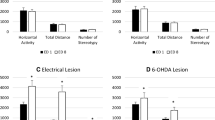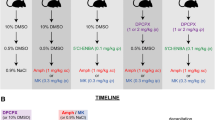Abstract
Direct injections of muscimol into the ventral tegmental area (VTA) or substantia nigra zona reticulata (SNR) have been used to selectively stimulate the mesolimbic and nigro-striatal dopamine pathways respectively. Such injections induced locomotor activity, rearing, sniffing and in some animals an intermittent grooming response. These responses were rapid in onset, dose-related and relatively short lasting (<40 min). Selective increases in dopamine turnover were seen in the nucleus accumbens and in the striatum following VTA and SNR injections of muscimol (100 ng) respectively. Haloperidol inhibited the behavioural consequences of VTA and SNR injections of muscimol with similar potency (ED50s 0.01–0.03 mg/kg IP), and fluphenazine did likewise (ED50s 0.05–0.16 mg/kg IP). However, thioridazine (ED50s VTA: 1.45–2.04 mg/kg IP, SNR 8.50–9.20 mg/kg IP) and in particular clozapine (ED50s VTA: 0.24–0.58 mg/kg IP, SNR: 6.10–9.70 mg/kg IP) were more potent at inhibiting the locomotor activity and sniffing responses due to VTA rather than SNR administered muscimol. Since dopamine D2 antagonists are believed to exert their anti-psychotic effects via an action on mesolimbic dopaminergic systems, and their ability to induce extrapyramidal side effects (EPS) is thought to be due to an action on nigro-striatal dopamine systems, these results suggest that the behavioural models described can be used to predict efficacy and side-effect liability of potential neuroleptic drugs.
Similar content being viewed by others
References
Arnt J, Scheel-Krüger J (1979) GABA in the ventral tegmental area: Differential regional effects on locomotion, aggression and food intake after microinjection of GABA agonists and antagonists. Life Sci 25:1351–1360
Bull DR, Palij P, Sheehan MJ, Miller J, Stamford JA, Kruk ZL, Humphrey PPA (1990) Application of fast cyclic voltammetry to measurement of electrically evoked dopamine overflow from brian slices in vitro. J. Neurosci Methods 32:37–44
Cooper SJ, Dourish CT (1990) An introduction to the concept of stereotypy and a historical perspective on the role of brain dopamine. In: Cooper SJ, Dourish CT (eds) Neurobiology of stereotyped behaviour. Clarendon Press, Oxford, pp 1–24
Dray A, Fowler LJ, Oakley NR, Simmonds MA, Tanner T (1977) Regulation of nigro-striatal dopaminergic neurotransmission in the rat. Neuropharmacology 16:511–518
Fallon JE, Loughlin SE (1985) In: Paxinos G (ed) The rat nervous system, vol 1. Academic Press, Sydney, pp 353–374
Hagan RM, Jones BJ, Jordan CC, Tyers MB (1990) Effect of 5-HT3 receptant agonists on responses to selective activation of mesolimbic dopaminergic pathways in the rat. Br J Pharmacol 99:227–232
Iversen SD (1986) Animal models of schizophrenia. In: Bradley PB, Hirsch SR (eds) The psychopharmacology and treatment of schizophrenia. Oxford University Press, Oxford, pp 71–102
Litchfield JT, Wilcoxon F (1949) A simplified method of evaluating dose-effect experiments. J Pharmacol Exp Ther 96:99–113
Ljungberg T, Ungerstedt U (1978) Classification of neuroleptic drugs according to their ability to inhibit apomorphine-induced locomotion and gnawing: evidence for two different mechanisms of action. Psychopharmacology 56:239–247
Meltzer HY, Stahl SM (1976) The dopamine hypothesis of schizophrenia. Schizophren Bull 2:19–76
Meltzer HY, Matsubara S, Lee JC (1989) Classification of typical and atypical antipsychotic drugs on the basis of dopamine D-1, D-2 and serotonin2 pKi values. J Pharmacol Exp Ther 251:238–251
Moore NC, Gershon S (1989) Which atypical antipsychotics are identified by screening tests? Clin Neuropharmacol 12:167–184
Paxinos G, Watson C (1982) The rat brain in stereotaxic co-ordinates. Academic Press, New York
Scheel-Krüger J, Arnt J, Magelund G (1977) Behavioural stimulation induced by muscimol and other GABA agonists injected into the substantia nigra. Neurosci Lett 41:351–356
Tschanz JT, Rebec GV (1989) Atypical antipsychotic drugs block selective components of amphetamine-induced stereotypy. Pharmacol Biochem Behav 31:519–522
Author information
Authors and Affiliations
Additional information
Preliminary accounts of these experiments were communicated to the “Animal Models in Psychopharmacology” and British Association for Psychopharmacology conferences held in Amsterdam and Cambridge, July 1990.
Rights and permissions
About this article
Cite this article
Oakley, N.R., Hayes, A.G. & Sheehan, M.J. Effect of typical and atypical neuroleptics on the behavioural consequences of activation by muscimol of mesolimbic and nigro-striatal dopaminergic pathways in the rat. Psychopharmacology 105, 204–208 (1991). https://doi.org/10.1007/BF02244310
Received:
Revised:
Issue Date:
DOI: https://doi.org/10.1007/BF02244310




